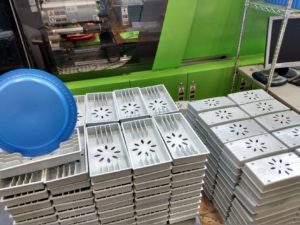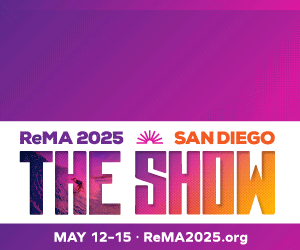Recyclers since 2019 have helped Connecticut middle schoolers and their communities recycle about 2.5 million plastic bottle caps into useful kitchen drying racks and storage tubs.
Last school year, 3,600 local middle school students, aided by an ISRI member and other industry participants, collected 812,000 caps as part of the One Million Bottle Cap Challenge set by Stamford, Conn.-based nonprofit SoundWaters. The nonprofit, which leads education efforts on how microplastics affect Long Island Sound, is concluding a three-year program funded by the National Oceanic and Atmospheric Administration (NOAA).
In the previous two school years (including a full pandemic school year), students collected over 1,672,000 bottle caps. The breakdown by school year is:
- 2019-20: 1,028,177 caps.
- 2020-21: 643,999 caps.
- 2021-22: 812,338 caps.
“The students took the project home and told their families; their parents took it to their offices,” explains Bob Mazzone, SoundWaters’ vice president of development. “We started hearing from people all over Stamford that the kids were bugging them to collect bottle caps. So, everybody in this town was collecting bottle caps. Then we started hearing from other school districts who were hearing about it, and they wanted to participate.”
A Worldwide Partnership
The One Million Bottle Cap Challenge found inspiration in Mazzone’s past: His fourth-grade teacher challenged the class to collect 1 million of something, which ended up being soda can tabs. The bottle cap challenge involved diverse contributors including ISRI member and recycling machinery supplier Van Dyk Recycling Solutions; injection molder Accudyn; masterbatch maker Amapcet; thermoformer Innovative Plastics Corp.; Penn State Behrend; the Society of Plastics Engineers Foundation; recycler Ultra-Poly Corp.; and the World Design Organization (WDO).
A $200,000 NOAA grant covered three years of bottle cap collection. Local schools, SoundWaters and the SPE Foundation are pleased with the results of the One Million Bottle Cap Challenge. “We hope that [the] students will become advocates for the responsible use of plastics and understand that the answer is not in banning or the wholesale removal of plastics from our society but that together, scientists, engineers, and the public can work together to continually improve all aspects of plastics production and end-of-life solutions,” says Eve Vitale, chief executive of the SPE Foundation.
Bottle Caps to Dish Racks
Plastics collected from bottle caps, polyethylene and polypropylene, can be recycled and made into new products. During the 2020-21 school year, a small group of Stamford sixth graders, led by the WDO, worked on a design challenge with professional industrial designers from around the world via Zoom to design a product that could be produced with their bottle caps. The winning design was a PE dish rack, perfect for small countertops.
“This was a professionally run desi gn challenge following industrial design protocols,” Mazzone explains. “As we were judging the designs, somebody pointed out that postconsumer plastic cannot touch food. So, the drying rack fit well.”
gn challenge following industrial design protocols,” Mazzone explains. “As we were judging the designs, somebody pointed out that postconsumer plastic cannot touch food. So, the drying rack fit well.”
SoundWaters worked with the SPE Foundation to find partners who could turn the students’ design into a product that could be made.
ISRI Member Essential to Process
Van Dyk optically sorted and separated PE and PP caps at its Norwalk, Conn., facility, and provided warehousing. Company President Pieter van Dijk has been a board member of SoundWaters for four years, and the company took part in the One Million Bottle Cap Challenge for two school years.
A team of 11 science teachers from Stamford Public Schools toured Van Dyk last school year and visited the company’s test center to see how material recovery equipment separates curbside recyclables.
“An organization like SoundWaters, which already does so much to educate the community on their environmental impact, can become even stronger by learning the process of curbside collection and sortation,” van Dijk says. “This arms them with more knowledge to pass on to the next generation and continue to improve the recycling process.”
Northampton, Pa.-based Ultra-Poly shredded, granulated, and pelletized all the collected materials. Twenty-five percent of the material was PP, which Ultra-Poly resold. As students did in 2020-21, classes at Penn State Behrend’s Plastics Training Academy worked out details of the computer-assisted design (CAD) and construction of molds, then molded the racks out of PE for 2021-22.
“After receiving the rough sketch of the design created by the students in Stamford, I drafted a CAD design of the part,” explains Christian Young, a recent Penn State Behrend graduate. “The design was created and modified to allow for proper injection molding. From there, the CAD part was used to create core and cavity mold halves.” A machinist at the college created a mold, then the Behrend Plastics Lab injection molded the final product.
“We produced 3,000 dish racks at 43 bottle caps per dish rack,” Mazzone explains. Some of the collected PE went to Inovative Plastics to be made into 800 utility tubs. Dish racks and tubs were given to schools that participated in the challenge. Penn State Behrend received leftover PE to use in its future educational programs.
What’s Next
Now that the One Million Bottle Cap Challenge is over, residents along the Long Island Sound have contacted SoundWaters with questions about what to do with their bottle caps in the future. Most notably, locals weren’t sure whether to recycle the caps by themselves or keep them on the beverage bottles.
 SoundWaters is advising residents to follow their communities’ recycling guidelines, even though those vary widely. Some communities ask residents to keep the cap on the bottles and recycle them together. Others want the caps removed before bottles and caps are placed in curbside bins. Still other communities ask residents to recycle bottles and send the caps to the landfill.
SoundWaters is advising residents to follow their communities’ recycling guidelines, even though those vary widely. Some communities ask residents to keep the cap on the bottles and recycle them together. Others want the caps removed before bottles and caps are placed in curbside bins. Still other communities ask residents to recycle bottles and send the caps to the landfill.
“It’s been an interesting journey for us to learn how we are still not capable of managing plastic waste in a real systematic way so that it’s clear and understandable,” Mazzone says.
Vitale says SPE will build on the success of the program since it already fits with the curriculum the organization teaches across the country through PlastiVan, an education outreach program. PlastiVan covers polymer science lessons like thermoplastics as well as recycling and productive reuse of materials.
After two years’ involvement in the challenge, Van Dyk has a better idea of what PE and PP bottles caps look like and how they act during sortation processes.
“We typically use our test center to help our material recovery facility (MRF) customers make purchasing decisions on new equipment,” van Dijk explains. “We also provide testing for brand owners or packaging manufacturers who want to ensure their new product or label will be properly sorted when it hits the recovery facility. The SoundWaters project allowed us to use our test center in a new way: to make an impact on our community’s children by helping them understand the full cycle of the recycling process and see their hard work turned into a finished product that benefits their environment.”
All photos courtesy of SoundWaters. Primary photo caption: Workers at Van Dyk Sorting Solutions feed PE and PP bottle caps collected by Stamford, Conn., area students into an optical sorter. Body photo 1: Finished dish racks await shipment to participating schools. Body photo 2: One of the utility tubs produced from recycled bottle caps.










